Dive Into About Golden Psycho and Its Story.
Dive Into About Golden Psycho and Its Story.
Blog Article
Everything About Psychotomimetic Compounds: Their Duty in Psychological Study
Psychotomimetic compounds, such as LSD and psilocybin, have amassed boosting interest in psychological research for their capability to duplicate psychotic symptoms and supply understanding right into numerous mental wellness problems. Their interactions within the brain, specifically through serotonin and dopamine paths, recommend a complex relationship in between consciousness and neurobiology that might open unique restorative methods. As researchers remain to investigate their possible applications, moral considerations bordering their use in professional settings end up being paramount, raising important inquiries concerning safety and informed permission that call for additional expedition.
Meaning of Psychotomimetic Substances
In the world of mental research study, psychotomimetic substances are compounds that can cause impacts appearing like those of psychosis, such as hallucinations, misconceptions, and modified understandings of truth - About Golden Psycho. These compounds can be categorized into various categories, including hallucinogens, dissociatives, and certain energizers, each generating distinct mental impacts
The pharmacological action of psychotomimetic substances often involves inflection of neurotransmitter systems, specifically those pertaining to serotonin, dopamine, and glutamate. Substances like lysergic acid diethylamide (LSD) primarily act on serotonin receptors, leading to extensive changes in sensory understanding and cognition.
The utility of psychotomimetics in research exists in their capability to simulate psychotic signs, providing a version for recognizing the underlying mechanisms of psychotic disorders such as schizophrenia. By studying the results of these compounds, researchers can obtain insights into the neurobiological and emotional processes that add to psychosis.
Moreover, psychotomimetic compounds have been checked out for their therapeutic possibility in dealing with various psychological health problems, including depression and stress and anxiety, highlighting their dual duty in both study and prospective clinical applications.
Historic Advancement and Context
The exploration of psychotomimetic substances has a rich historical context that goes back to ancient human beings, where materials such as psilocybin mushrooms and peyote were utilized in spiritual and recovery practices. These very early usages usually intertwined with religious routines, suggesting a profound respect for the modified states of awareness induced by these substances.
The mid-20th century marked a significant pivotal moment in the research study of psychotomimetic materials, particularly with the synthesis of LSD by Albert Hofmann in 1938. The subsequent popularization of LSD in the 1960s militarized a wave of passion in both its emotional effects and prospective therapeutic applications. Researchers started to investigate how these compounds can mimic psychotic states, offering insights right into mental disease.
However, the boosting organization of psychotomimetics with counterculture activities brought about regulatory backlash, culminating in the criminalization of most of these compounds. In spite of these obstacles, the rebirth of passion in the therapeutic potential of psychedelics in the 21st century has prompted renewed research. This historical trajectory highlights the progressing assumption of psychotomimetic substances, changing from spiritual compounds to topics of clinical inquiry and, potentially, therapeutic promise.
Mechanisms of Action
Understanding the mechanisms of activity of psychotomimetic substances discloses the detailed means these materials engage with the mind's neurochemistry. These compounds mainly exert their effects via inflection of natural chemical systems, especially serotonin, dopamine, and glutamate. For circumstances, numerous classic psychedelics, such as psilocybin and LSD, mainly function as agonists at serotonin 5-HT2A receptors, resulting in altered perception and cognition. This communication not just impacts sensory processing yet likewise enhances psychological and reflective experiences.
In enhancement to serotonin, dopaminergic pathways are substantially influenced by substances like mescaline and particular cannabinoids, which can result in transformed states of consciousness and changes in mood and motivation. The NMDA receptor incongruity observed with substances like ketamine highlights one more pathway with which psychotomimetics might induce dissociative states and extensive alterations in assumed processes.
The neurochemical waterfalls started by these communications result in complicated and multifaceted mental results. Understanding these systems is essential for both the development of emotional study and the restorative potential of psychotomimetic compounds, as they give understandings into the underlying neural correlates of modified states of awareness.
Current Research and Applications
Current examinations into psychotomimetic compounds have exposed a rebirth of passion in their healing applications, particularly in the areas of psychiatry and psychology. Researchers have begun discovering compounds such as psilocybin, LSD, and ayahuasca for their prospective to alleviate symptoms connected with different psychological health and wellness conditions, consisting of anxiety, anxiousness, and PTSD.
Medical tests have demonstrated click here to read that, when administered in controlled settings, these substances can promote profound emotional experiences, advertising psychological innovations and boosted therapeutic results. For example, research studies have shown that psilocybin-assisted therapy can bring about substantial decreases in treatment-resistant anxiety, with effects lasting for a number of months post-treatment.
Furthermore, psychotomimetic substances are being examined for their capability to foster neuroplasticity, possibly enabling for even more efficient rewiring of maladaptive thought patterns. These searchings for suggest that such substances might serve as complements to traditional psychotherapeutic approaches, improving the efficacy of restorative interventions.
As study progresses, the emphasis is moving in the direction of comprehending the optimal dosages, healing settings, and individual qualities that can maximize the benefits of these substances. find out This growing area holds guarantee for changing mental wellness treatment standards and resolving the restrictions of standard psychiatric medicines.
Ethical Considerations in Study

Navigating the moral landscape of research including psychotomimetic compounds is vital to ensuring individual safety and the stability of research outcomes. Scientists must prioritize enlightened permission, making sure that participants completely recognize the potential dangers and advantages related to the materials being studied. This includes providing in-depth details about feasible emotional effects, consisting of acute and long-lasting influences, and allowing participants the chance to take out from the study at any moment without fine.
Furthermore, honest oversight by institutional testimonial boards (IRBs) is vital. IRBs examine research protocols to protect individual well-being and copyright honest criteria. This scrutiny helps reduce dangers and makes sure that researches are performed with scientific rigor. Additionally, the capacity for coercion should be very carefully analyzed, specifically when susceptible populations are involved.
Confidentiality is an additional critical consideration. Researchers must implement durable procedures to safeguard participants' identifications and information, especially given the delicate nature of experiences connected with psychotomimetic compounds (About Golden Psycho). Inevitably, a dedication to ethical practices not just promotes trust in click over here now between researchers and individuals however also boosts the credibility and legitimacy of the research study outcomes, adding to the development of emotional understanding

Final Thought
In conclusion, psychotomimetic substances, especially classic psychedelics such as LSD and psilocybin, deal considerable insights right into mental disorders via their distinct mechanisms of activity. Their healing capacity in addressing problems like stress and anxiety and PTSD underscores the value of continued study in this field. Nonetheless, guaranteeing moral requirements in study methods is crucial for individual safety and notified authorization, enabling for a liable exploration of these substances' benefits and ramifications within psychological science.
Report this page